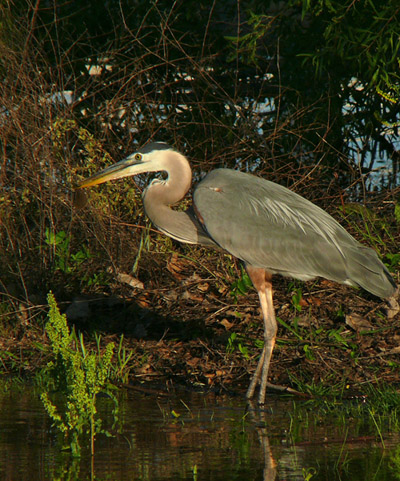by John Shackford

To me there is something a bit eerie and other-worldly about the Great Blue Heron (Ardea herodias). A.C. Bent, in his species life histories (website: http://birdsbybent.com/ch1-10gbh.htm), says that “ [I]t is a stately bird, dignified in its bearing, graceful in its movements and an artistic feature in the landscape…..[p]erhaps you have seen it from afar and think you can gain a closer intimacy, but its eyes and ears are keener than yours; and it is a wise and a wary bird.” Other ornithologists have commented on this wariness. When it launches into flight it settles into slow wingbeats that add a languid feel to the species’ persona. Also there is a languid feel to the bird’s search for food; it stands still or steps very slowly forward, using patience, as it tries to catch fish, crawfish or other aquatic fare. But I would hate to be looking up along this bird’s long bill and into its eyes if I were prey: for one instant this heron is very quick, striking well forward of its body with its long neck and bill.
Of its food, Bent (same website) cites Audubon: “The principal food of the great blue heron is fish of all kinds; but it also devours frogs, lizards, snakes, and birds, as well as small quadrupeds, such as shrews, meadow mice, and young rats, all of which I have found in its stomach.” Audubon also mentions aquatic insects, moths and butterflies. With even more items of prey mentioned by Audubon and other observers, this species clearly has a broad array on its dining menu; it can seek prey well away from water.
Although some Great Blue Herons migrate into Oklahoma in winter, the species is considered a permanent resident throughout the state. Its status in Oklahoma has changed dramatically in the last few decades. Once a quite hard bird to find on our Christmas Bird Counts, it now shows up all over our count area: on our most recent count, 13 field parties (all field parties that were in the field more than 30 minutes) found at least 1 Great Blue Heron, with a total of 131 birds.
The Great Blue Heron is one of the earliest of our nesters. Although I am having trouble documenting it, I believe that by mid-February or so in recent years, birds start showing up in their nesting colonies, long before leaves come out in the spring. So it is time to start watching for nesting activity. There is a colony of some 25-30 nests on Waterloo Road 3/4ths mile east of Highway 74; you will see the nests in big cottonwoods about 1/4th mile to the north of Waterloo Road. Bent (same website) says that “[o]n the plains and prairies of the interior the great blue herons have to be contented with the largest trees they can find, cottonwoods, poplars, and box elders, in the timber belts along the streams.” Great Blues usually nest in relatively small colonies of 10-30 nests and tend to return to those colonies year after year. They build a platform nest like most other herons and lay 3-7 (rarely) eggs, but usually 4. The number of years they return to a nesting location usually seems to be related to how long the large trees in the area will support their nests, assuming the birds are not harassed at that location.
One thing that is a bit afield from Oklahoma ornithology is the “Great White Heron,” currently classified as a form of the Great Blue. I enjoy the fact that this pairing of two forms is more strikingly different than the pairing of “Snow” and “Blue” goose forms of the Snow Goose. The “Great White Heron” has beautiful pure white plumage and is normally found in southern Florida, Cuba, and coastal areas of the Yucatan Peninsula. So if you ever travel that way…….
